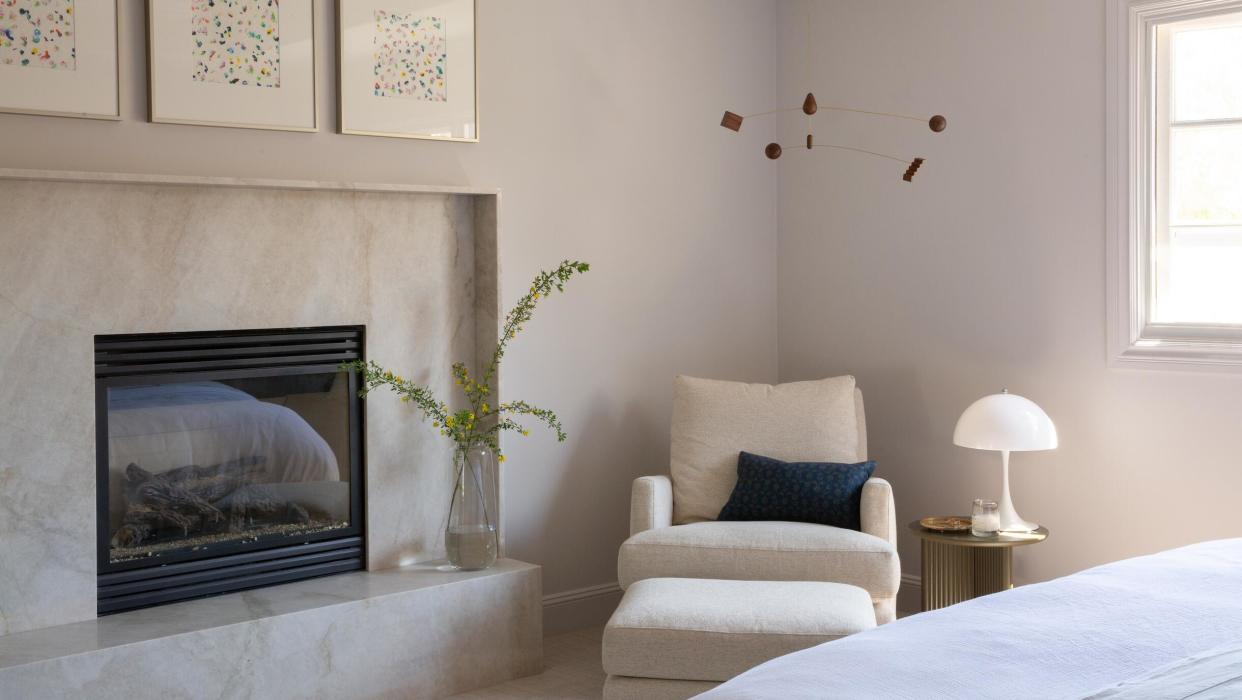Subcontractor screw-ups are inevitable. How you handle it is what counts

designer toolkit | May 16, 2024
A stoneworker’s error forced Grace Lee-Lim to problem-solve creatively—with stunning results. Here’s how she went back to the drawing board and made it work.
It was the final stretch of a long project, and everything was coming together beautifully—until Grace Lee-Lim saw the fireplace surround that had been installed in the primary bedroom. The stone was intended to be cut in three pieces, with two equally wide sides and a narrower top, but the stone fabricator had instead cut it into a single, symmetrical square, with all sides equidistant from the center. Lovely, yes, but not what Lee-Lim had specified.

“The change only added about 3 inches to the top, but it made a big visual impact to the 225-square-foot bedroom,” says the Los Angeles designer, who had been working on the 2,900-square-foot home in Burlingame, California, for nearly 18 months. Both the client and the team of subcontractors were new to Lee-Lim, but the project was on schedule, and everyone had been overperforming. “The general contractor was the most excellent, organized contractor I’ve worked with, and all of his tradespeople were incredible,” she says. “We had worked with the same stone fabricator for this client’s living room fireplace and kitchen countertops, and they exceeded all expectations through that process.”
Though satisfied with the work up to that point, the designer had remained clear and careful in her communications with the fabricator, providing detailed CAD drawings for how to cut the stone—a slab of Perla Venata honed quartzite left over from the kitchen counters. “After verifying that all the drawings and measurements were understood, we didn’t think there would be any misstep,” she says. “It was only after they already glued the stone to the wall and installed the surrounding frame that we realized the stone wasn’t cut to our specifications. It was too late for them to remove it without damaging the entire wall and jeopardizing the slab.”
Some might have lost it, but Lee-Lim kept her cool. “I’ve learned that panic mode never really gets you anywhere,” she says. “Of course, there are emotional waves, but you have to face what’s in front of you as logically as you can, which usually means figuring out a solution as quickly as possible.”
Her next step was to update the client on the error and form a backup plan—but
not at the same time. “I try to approach these conversations as pragmatically as possible,” she says. “I had to explain the situation, and initially the clients really did not like the change. They needed time to process it. I gave them the space to do so before giving them a barrage of ideas or solutions.”
Meanwhile, Lee-Lim explored every possible fix with the stone fabricator. “They didn’t have much of an explanation,” she says. “They took ownership [for the mistake] and were apologetic, and also wanted to reach a compromise.” But in terms of rectifying the situation, the options were limited: Removing the surround risked damaging the stone itself, and since the slab was a remnant from the kitchen, bringing in new stone to repair any damage could result in a color discrepancy.
Instead, Lee-Lim sought visual strategies to offset the surround’s scale and make it feel intentional. “The situation forced us to think critically about the space and its proportions within the existing boundaries,” she says. Her team explored different ideas on CAD, then presented a solution. “We ultimately added a triptych of artwork in the empty space above the fireplace so the whole wall was filled out, and a custom mobile that helped balance the visual negative space above the client’s existing lounge chair. The client’s bed also ended up getting damaged by the painters, so we were able to replace it with a custom bed with a higher headboard that mirrored the fireplace height.” (The contractor covered the cost of the bed since the painters were his hire.)
When all was said and done, the new concept was a success. “The clients ended up really loving the result,” says Lee-Lim. “It wasn’t what we designed, but I thought it looked so beautiful. I can be very objective when I look at things, and I know when things need to be scrapped and redone versus when things should be left as is and will grow on you over time.” And though her firm did eat the cost of additional time spent to correct the issue—from sourcing new product to creating CAD drawings and communicating with vendors—the project only ended up being delayed by a few weeks.
For Lee-Lim, the experience highlighted the importance of maintaining the firm’s close supervision of subcontractors, even top-tier ones. “No matter how much you trust others, you have to go through the painstaking effort to ensure that your vision is being executed to the exact specifications that you request—there is really no such thing as checking in too much,” she says. And in the event of inevitable (hopefully rare) errors, positivity and resourcefulness are paramount. “I approach every situation with the perspective that although a mistake was made, there are always creative solutions, and we can work together to reach a place where everyone is happy with the outcome.”
This article originally appeared in Spring 2024 issue of Business of Home. Subscribe or become a BOH Insider for more.

